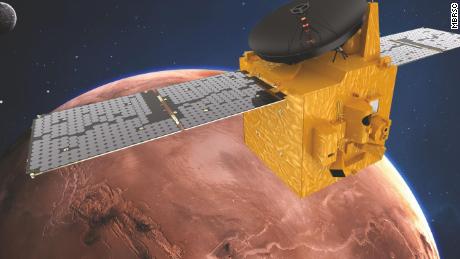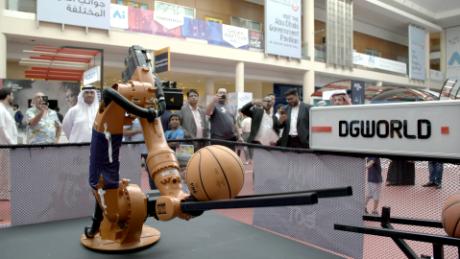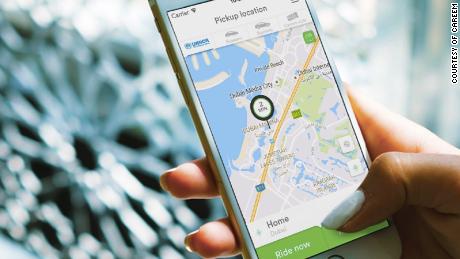CNN's series often carry sponsorship originating from the countries and regions we profile. However, CNN retains full editorial control over all of its reports. Our sponsorship policy.
(CNN)Dubai has gone from Middle Eastern upstart to regional powerhouse in the space of a generation, buoyed by its diverse economy -- from freight and finance to transport and tourism. A city firmly on the move, CNN took a whistlestop tour around the places that keep Dubai ticking, and crunched the numbers underpinning its success.
1966
 Photo: Dubai Petroleum
Photo: Dubai PetroleumOil discovered
Oil is discovered offshore in Fateh. Extraction operations begin in 1969 and in the 1970s three giant submarine tanks are completed, each capable of holding half a million barrels and known as the "Three Pyramids of Dubai."
1972
 Photo: Nasser Younes/AFP/Getty
Photo: Nasser Younes/AFP/GettyPort Rashid opens
Dubai consolidates its position as a key maritime hub for the Gulf, constructing a deepwater harbor with 11 berths, rising to 35 with further development.
1979
 Photo: Rabih Moghrabi/AFP/Getty
Photo: Rabih Moghrabi/AFP/GettyDubai World Trade Centre inaugurated
The city welcomes the Dubai World Trade Centre. Designed by British architect John Harris, the 489-foot structure dominates the sparsely populated skyline and becomes a home for Dubai's burgeoning financial industry.
1979
 Photo: Nasser Younes/AFP/Getty
Photo: Nasser Younes/AFP/GettyJebel Ali Port opens
The largest manmade harbor in the world when it opens, the mega-project is so vast it can be seen from space. Through expansions, by 2018 the port will have the capacity to handle over 22 million container units.
1985
 Photo: Jafza
Photo: JafzaFirst free trade zone established
The Jebel Ali Free Zone Authority (known as Jafza) is set up, attracting international companies by offering 100% foreign ownership of businesses and waiving corporate taxes. Begins a trend with more than two dozen free zones later established in Dubai.
1985
 Photo: Emirates
Photo: EmiratesEmirates airline launches
The royal family-backed airline makes first flight on October 25 to Karachi, Pakistan. New Delhi and Bombay (now Mumbai) are among Emirates' first routes, with 288,000 passengers flown in the airline's first full year of service.
1999
 Photo: Patrick Baz/AFP/Getty
Photo: Patrick Baz/AFP/GettyBurj Al Arab welcomes first guests
The tallest building in Dubai and the tallest hotel in the world when it opens. Built on an artificial island off the coast, it sets a new standard for luxury. The Burj's helipad becomes the location for numerous headline-making publicity stunts.
2001
 Photo: Karim Sahib/AFP/Getty
Photo: Karim Sahib/AFP/GettyPalm Jumeirah begins construction
A huge land reclamation process starts north of Jebel Ali. Boats pump sand from the seabed, forming a palm-shaped island and crescent-shaped breakwater, covering 560 hectares when completed. Hotels and private residences are later built and connected to the mainland by road and monorail.
2005
 Photo: Jason Alden/Bloomberg via Getty Images
Photo: Jason Alden/Bloomberg via Getty ImagesDubai Gold and Commodities Exchange begins trading
The "City of Gold" opens the first commodity derivatives exchange in the region. The exchange is trading $404 billion of commodities in 2017 with over 200 trading members globally.
2008
 Photo: Karim Sahib/AFP/Getty
Photo: Karim Sahib/AFP/GettyDubai Mall opens
Spanning 5.4 million square feet and with retail space for 1,200 stores, Dubai Mall sets a world record for the largest mall by total area. Along with luxury brands, the mall's vast aquarium and modern gold souk are among its lead attractions.
2010
 Photo: Marwan NaamanI/AFP/Getty
Photo: Marwan NaamanI/AFP/GettyBurj Khalifa completed
Smashing the record for the world's tallest building, the tower stands 2,716 feet (828 meters) and 200 stories high, taking six years and 22 million man-hours to complete. The skyscraper acts as a new focal point to the city.
2013
 Photo: Karim Sahib/AFP/Getty
Photo: Karim Sahib/AFP/GettyWins Expo 2020 bid
The UAE becomes the first nation in the Middle East to win a bid to host a World Expo, beating out Russia, Brazil and Turkey. A 438-hectare site in Dubai South is earmarked for the six-month global culture and innovation event, with the government anticipating 25 million visitors.
2014
 Photo: Nicolas Economou/NurPhoto/Getty
Photo: Nicolas Economou/NurPhoto/GettyDubai International Airport becomes #1
Dubai's principal airport overtakes London Heathrow to become the busiest airport in the world by international passenger traffic, according to Airports Council International. Its three terminals serve more than 100 airlines, 240 destinations and a projected 90 million passengers in 2018.
2015
 Photo: Khushnum Bhandari/Bloomberg/Getty
Photo: Khushnum Bhandari/Bloomberg/GettyMohammed Bin Rashid Space Center established
The new center merges with the Emirates Institute for Advanced Science and Technology, expanding the UAE's space operations.

























































